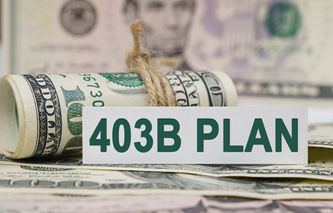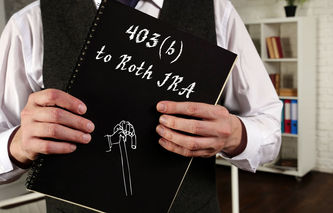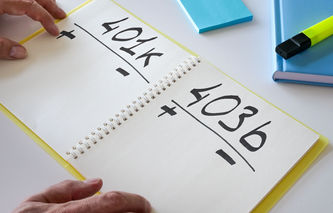Generally, it's possible to roll-over all or any part of a distribution from a 403(b) plan to a Traditional IRA or an eligible retirement plan without paying any taxes. This includes Roth IRAs, a 457 plan, and even another 403(b) account.
403(b) Rollover Rules
Anyone thinking about initiating a rollover needs to be aware of some important rules, especially if a distribution is made directly to the plan participant. Performing a rollover incorrectly can result in an unnecessary tax penalty; which is why it's so important to follow the rules enforced by the Internal Revenue Service (IRS).
Sixty-Day Rollover Rule
Normally, a 403(b) rollover needs to be completed by the 60th day following the day the accountholder received any distribution. If the money is rolled over into another account, then meeting the requirements of this 60-day rule shouldn't be problematic. Anyone inadvertently holding onto the money past the 60th day can be subjected to a very unpleasant tax penalty.
The IRS does allow for two exceptions to the 60-day rule. The first has to do with unforeseen circumstances or hardships.
Hardship Exceptions
The IRS can waive the 60-day rollover rule if an individual can provide evidence they've experienced some kind of financial hardship. The hardship can take a number of forms, but should be beyond the reasonable control of the individual making the rollover, such as a hospitalization or some other unforeseen disaster.
Individuals in need of a hardship exemption need to apply for an IRS waiver of the 60 day rollover requirement. Application fees may be required.
Exemptions are not automatically granted, and the IRS uses some of the following factors to determine whether an exception should be granted:
Errors made by financial institutions or banks
Delays due to postal errors, hospitalization, or disability
Whether or not the accountholder used the 403(b) distribution in any way, including cashing the check
The amount of time that has passed since the distribution
The second exception to the 60-day rollover rule has to do with money being frozen in an account.
Frozen Deposit Exception
The 60-day rule for completing a 403(b) rollover can be extended for any amount of time if the distribution is frozen in a bank deposit or with a financial institution. In addition, the 60-day period cannot end any earlier than ten days after the account is no longer frozen.
To qualify as a frozen deposit, the account must be with:
A financial institution that is bankrupt or insolvent, or
The state in which the bank is located has placed limits on withdrawals because one or more financial institutions of that state are bankrupt or insolvent.
Rollovers to 403(b) Plans
Individuals receiving a distribution from another 403(b) plan, or any other eligible retirement plan, can roll that money into a 403(b) plan on a tax-free basis. If the distribution contains both pre-tax and after-tax contributions, then the money that is rolled-over is first treated as pre-tax amounts.
This is an important rule to understand. If the account has a mix of pre-tax and after-tax money, and only a portion of the distribution is rolled over, then the money involved in the rollover is treated as the pre-tax portion of the account first.
Rollover Example
Let's say Mr. Conservative decided not to roll over the entire distribution but only an amount equal to the pre-tax dollars. The above rule means he would not have to declare the remaining distribution as income, since he's already paid income tax on this portion of the money.
Rollovers to 401(k) Plans
In general, it's possible to rollover a 403(b) account into most qualified retirement plans. This includes Traditional IRAs, 401(k) plans, SEP IRA, and even a Roth IRA after December 31, 2007 (although some amounts may be included in taxable income). It's not possible to conduct a rollover into a SIMPLE IRA.
Withholding Rules
There are basically two ways that distributions from a 403(b) can be made: to the accountholder (an individual), or directly into another qualifying retirement plan. Plan participants deciding to receive a distribution directly need to be aware of the withholding rule that will apply under those conditions.
Distributions to Individuals
When distributions that are qualified to be rolled over are made directly to an individual, they'll typically receive only 80% of the distribution. That's because 20% of the money needs to be withheld. But in order to avoid a tax penalty, the entire amount needs to be rolled over.
Anyone deciding to take the distribution directly needs to make up the 20% that is withheld from other sources in order to rollover 100% of the amount involved. If the individual cannot make up the 20% that is withheld, then they may have to declare the 20% as income and face additional tax penalties.
After satisfactorily rolling over 100% of any distribution, the remaining 20% will be released back to the accountholder. Because of the withholding rule, most individuals roll over their account by making what are called direct rollovers.
Direct Rollovers
Accountholders also have the option of having their 403(b) plan administrator make the rollover directly to an IRA, a new 403(b) plan, or any of the other qualifying retirement plans. This is the most common way to make a rollover because the 20% withholding rule does not apply. It's also one of the easiest ways to conduct a rollover since the accountholder only needs to coordinate the exchange of the distribution between the two financial institutions.
Unless there is a very good reason for taking possession of the money involved in a rollover, the best choice is to make a direct, plan-to-plan, withdrawal and deposit.
Non-Qualifying Distributions
We're going to finish this article with a quick list of 403(b) distributions that do not qualify for a rollover on a tax-free basis:
Minimum distributions (which are usually required beginning at age 70 1/2)
Distributions taken in substantially equal payments over one's life expectancy
Substantially equal payments taken over the life of a joint beneficiary
Distributions that are taken in substantially equal payments over a period of 10 years or more
Qualifying hardship distributions
Additional Resources




